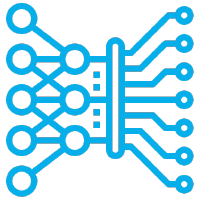

A cybersecurity company based in North America wanted to create an advanced intrusion detection system for its clients. The solution must be innovative and proactive to address emerging threats for large companies and enterprises.
Containing threats was not the sole objective. Besides real-time protection and threat neutralization, the new solution must also detect suspicious activities that could emerge as future threats. We had less than 3 months to complete the project.

The client had no clue how to handle zero-day attacks, which explore unknown threats and vulnerabilities that render companies defenseless. Neither their security vendors nor their in-house IT team had patches or proactive strategies to handle zero-day attacks. Moreover, the existing security systems relied solely on known attack signatures.

High false positive rates in the threat detection system consumed significant IT resources. Security teams found little to no time to handle genuine threats. Besides time and resource wastage, the false positives increased response times for potential security breaches.

Our client wanted to scale his resources during peak times and ensure optimal security 24/7. Increased traffic and extensive security demands compromised performance and led to delays in threat detection. These challenges were a threat to data safety and productivity.


We created a hybrid model that embraced supervised and unsupervised learning techniques. Unsupervised learning helps in countering zero-day attacks by analyzing regular network behavior and identifying anomalies. On the other hand, supervised learning uses historical data to train models and facilitate the detection of specific attack signatures.

Network traffic metadata holds valuable descriptive data related to network traffic. We extracted, analyzed, and managed relevant data from the network traffic metadata to enhance the security and reliability of the system. Other benefits include reduced false positives and enhanced threat intelligence.

The client wanted seamless resource scaling and real-time analysis of network data. We optimized the model using Apache Spark and deployed Kubernetes for distributed processing to achieve this objective. This ensured smooth expansion without any latency issues.

Launching the MVP required a team of six technical experts and 10 weeks. Our efforts paid off, and the client was pleased with the results. After implementing the solution, the client experienced a 35% drop in undiscovered network instructions and a 40% decrease in false positives. Also, thanks to our network intrusion detection system, the client experienced a sharp reduction in alert fatigue.
Most importantly, the solution’s scalability enabled the client to handle increased business demands without compromising security and confidentiality.

Python

Scikit-learn

Elasticsearch

TensorFlow

Docker
401, One World West, Nr. Ambli T-Junction 200, S P Ring Road, Bopal, Ahmedabad, Gujarat 380058
Kemp House 160 City Road, London, United Kingdom EC1V 2NX
Nürnberger Str. 46 90579 Langenzenn Deutschland
Level 36 Riparian Plaza, 71 Eagle Street, Brisbane, QLD 4000
4411 Suwanee Dam road, Bld. 300 Ste. 350 Suwanee GA, 30024
Cube Work Space, 24 Hans Strijdom Avenue, Cape Town
B 503 Sama Tower, Sheikh Zayed Road, United Arab Emirates
34 Applegrove Ct. Brampton ON L6R 2Y8
This website uses cookies so that we can provide you with the best user experience possible. Cookie information is stored in your browser and performs functions such as recognising you when you return to our website and helping our team to understand which sections of the website you find most interesting and useful.
Strictly Necessary Cookie should be enabled at all times so that we can save your preferences for cookie settings.
If you disable this cookie, we will not be able to save your preferences. This means that every time you visit this website you will need to enable or disable cookies again.